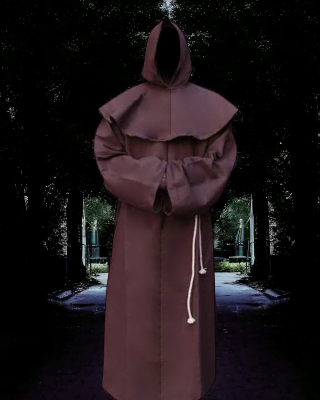Clergy Robes for Men
The Role of Monk Robes in Modern Religious Life
The Role of Monk robes have been a symbol of spiritual dedication and monastic life for centuries. These garments, worn by men and women who dedicate their lives to religious pursuits, are more than just clothing; they are a physical manifestation of the vows and commitments that guide the monastic way of life. Among the various orders, the Benedictine Habit and Franciscan Monk Robes stand out for their historical significance, unique designs, and deep spiritual meanings. This blog delves into the origins, evolution, and significance of these sacred garments, providing fresh insights into their role in the monastic tradition.
The Origins of role of Monk Robes
Monk robes trace their origins back to the early Christian monastic communities in the deserts of Egypt, Palestine, and Syria around the 3rd and 4th centuries. These early monks, known as Desert Fathers, wore simple tunics made of coarse materials, symbolizing their renunciation of worldly pleasures and their commitment to a life of poverty and simplicity. The design of these early robes was intentionally austere, reflecting the monks’ desire to distance themselves from the materialism and vanity of the world.
As monasticism spread throughout Europe, the design and role of monk robes evolved, adapting to the cultural and environmental contexts of different regions. By the Middle Ages, distinct monastic orders had developed, each with its own unique style of robe that reflected the order’s specific spiritual focus and practices.
Franciscan Monk Robes: Embracing Poverty and Humility

The Franciscan Order, founded by St. Francis of Assisi in the early 13th century, is known for its radical commitment to poverty, simplicity, and humility. The Franciscan Monk Robes are a powerful expression of these values, embodying the order’s dedication to living in solidarity with the poor and marginalized.
The Franciscan Monk Robes are characterized by their plain and unadorned design, typically made of coarse, undyed wool or linen. The robes are usually grey or brown, reflecting the earthiness and humility that are central to the Franciscan way of life. The most distinctive feature of the Franciscan habit is the cord cincture, which is tied around the waist with three knots, each representing the vows of poverty, chastity, and obedience.
Unlike the more elaborate robes of some other monastic orders, the Franciscan Monk Robes have remained largely unchanged since their inception. This consistency reflects the order’s commitment to the ideals of St. Francis, who believed that clothing should serve as a constant reminder of one’s spiritual poverty and dependence on God’s providence. The simplicity of the robes also facilitates the Franciscan mission of moving among the people, serving the poor, and preaching the Gospel.
Recent studies have highlighted the role of the Franciscan Monk Robes in the order’s outreach efforts. The robes’ simplicity and earth tones made Franciscan monks less intimidating to the rural and urban poor they served, helping to bridge the gap between the clergy and the laity. This intentional design choice not only reflected the Franciscans’ spiritual values but also enhanced their effectiveness in ministry, making them more approachable and relatable to the people they sought to help.
The Benedictine Habit | A Symbol of Stability and Obedience
The Benedictine Order, founded by St. Benedict of Nursia in the 6th century, is one of the oldest and most influential monastic communities in the Christian tradition. The Benedictine Habit is a simple yet profound garment that encapsulates the core values of the order: stability, obedience, and conversion of life.
Design and Symbolism
The Benedictine Habit typically consists of a tunic, scapular, cowl, and cincture. The tunic is a long, loose-fitting robe that covers the body from neck to ankles, usually made of black or dark brown wool. The scapular is a wide piece of cloth worn over the shoulders, signifying the monk’s willingness to bear the yoke of Christ. The cowl, a hooded cloak, is worn during prayer and symbolizes the monk’s withdrawal from the world to focus on spiritual matters. The cincture, a simple belt, represents the monk’s commitment to chastity and self-discipline.
Historical Evolution
Over the centuries, the Benedictine Habit has undergone some changes, primarily in response to practical needs and regional variations. However, its core elements have remained remarkably consistent, reflecting the order’s emphasis on stability and continuity. The habit’s black color, for instance, has long been associated with mourning and penance, underscoring the Benedictine monk’s constant awareness of mortality and the transient nature of worldly life.
New Insights
Recent research into the history of the Benedictine Habit has revealed that the choice of materials and colors was not merely symbolic but also practical. In the harsh climates of medieval Europe, wool provided warmth and durability, while the dark color helped conceal dirt and wear, reducing the need for frequent washing in environments where water was scarce. This blend of symbolism and practicality highlights the Benedictine order’s deep understanding of the interconnectedness of the spiritual and material worlds.
Role of Monk Robes in Modern Times
While the core elements of the Benedictine and Franciscan habits have remained consistent over the centuries, modern monastic communities have adapted these garments to contemporary needs and contexts. Some communities have adopted lighter materials, such as cotton or synthetic blends, to accommodate warmer climates or to make the robes more comfortable for daily wear. In some cases, the colors of the robes have been adjusted to reflect the cultural or liturgical traditions of the region.
However, the spiritual significance of these robes remains unchanged. For modern monks, the habit is still a powerful symbol of their vows and their commitment to a life of prayer, community, and service. In a world that is increasingly focused on materialism and individualism, the monk’s robe serves as a countercultural statement, reminding both the wearer and those who see it of the enduring value of simplicity, humility, and spiritual dedication.
Conclusion | The Enduring Legacy of Monk Robes
Monk robes, whether in the form of the Benedictine Habit or the Franciscan Monk Robes, continue to serve as profound symbols of the monastic life. These garments are not just relics of the past but living expressions of the values and commitments that define the monastic vocation. As monastic communities continue to adapt to the challenges of the modern world, the robes they wear will undoubtedly continue to evolve, but their core significance will remain unchanged.
For those interested in exploring the world of monastic attire, there are now online stores that specialize in clergy garments and accessories. Clergy Wear Shop, for example, offers a wide range of high-quality monk robes, Benedictine habits, Franciscan robes, and other ecclesiastical garments. Whether you are a member of a religious order, a clergy member, or simply someone interested in the spiritual heritage of these garments, Clergy Wear Shop provides a convenient and reliable source for all your needs.
Frequently Asked Questions (FAQs)
Why do monks wear robes?
Monks wear robes as a symbol of their religious vows, including poverty, chastity, and obedience. The robes also serve as a visible expression of their commitment to a life of prayer, community, and service.
How have monk robes evolved over time?
While the core elements of role of monk robes have remained consistent, they have evolved in response to practical needs, such as climate and cultural context. Modern adaptations include the use of lighter materials and adjustments in color to reflect regional traditions.
What is a monk’s hooded robe called?
A monk’s hooded robe is often called a cowl. The cowl is a long, hooded garment worn by monks in many Christian monastic traditions, particularly in Benedictine and Cistercian orders. It serves as both a robe and a protective covering for the head.
What do monks wear?
Monks wear habits; a simple, unadorned robe that symbolizes their vow of poverty and commitment to a spiritual life. The style, color, and design of the habit can vary depending on the religious order, but it is typically made of simple materials such as wool or cotton.
What monks wear hoods?
Monks in several Christian monastic orders wear hoods, particularly those in the Benedictine, Cistercian, and Trappist orders. The hood, part of the cowl, symbolizes the monk’s separation from the world and his dedication to a life of prayer and contemplation.
Why do monks wear red robes?
Red robes are commonly associated with Tibetan Buddhist monks. The color red is significant in Tibetan Buddhism as it represents power, courage, and transformation. Red robes also indicate a monk’s role and spiritual advancement within the Buddhist hierarchy.

 Clergy Cassocks for Men
Clergy Cassocks for Men Clergy Cassocks for Women
Clergy Cassocks for Women Clergy Robes for Women
Clergy Robes for Women Clergy Shirts for Men
Clergy Shirts for Men Clergy Shirts for Women
Clergy Shirts for Women